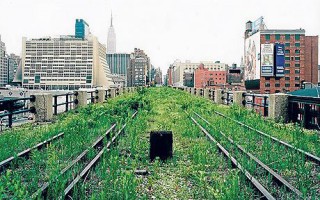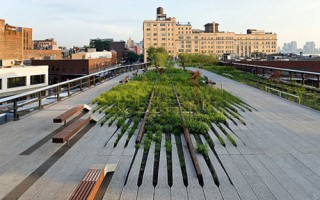
The dilapidated train line, circa 1985

The same train line, $170 millions later
‘A disused train line is being transformed into a dramatic, green space’, writes Douglas Rogers in ‘The Telegraph’.
Ironically, the success of the High Line is the result of a misappropriation: the elevated West Side railroad line was built in 1934 for safety reasons – so many accidents occurred between freight trains and other traffic that 10th Avenue was known as “Death Avenue”. The fact that the most innovative park in New York – and perhaps its most successful public project of the past 50 years – was originally built for an entirely different purpose, seriously questions the use of city planning and the wisdom of having architects in charge of designing the city.
Each of the many new uses of the structure – from walkway to sun deck to art installation place – is hardly a daring architectural proposition. The opposite is true: the old railroad line presented extraordinary moments of urban layering, hybridization and collision that far exceeded the most radical theoretical projects on the contemporary city. In fact, Bernard Tschumi, Steven Holl and Rem Koolhaas – to name but a few – have variously constructed diminutive versions of the high line in form of ‘visionary’ architecture and urban theory at least since the 70s.
While the final result is a truly exceptional space, the High Line is the achievement of Robert Hammond and Joshua David’s stand against demolition orders by Mayor Giuliani – and the social activism of celebrity residents – more than the work of architects. The high line has been simply ‘normalized’ – parapets and handrails, lighting, fancy benches, and cordons around the edges – so that it could be tolerated by the real estate community developing the area. No longer able or willing to alter the signifiers – buildings, streets, public spaces – architects are relegated to creating new semantics for the same old, exhausted city: the grass growing for decades over the dilapidated high line was a sign of urban decay until it was rebranded as a walkway-in-the-sky and a unique outdoor New York landmark. Interestingly, its physical presence was not altered; if anything, it lost some of its original transgressive power.
The high line project suggests a role for architects as curators and interpreters of a physical world that they are no longer able to shape. Here, the critically acclaimed work of architecture becomes a disingenuous effort at rebranding what already existed.